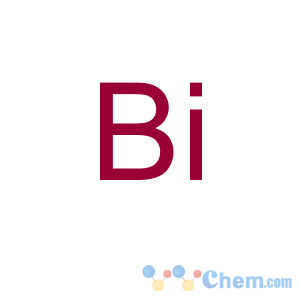Title: Bismuth
CAS Registry Number: 7440-69-9
Literature References: Bi; at. wt 208.98040; at. no. 83; valence 3, 5. Group VA (15). One naturally occurring isotope: 209; artificial radioactive isotopes: 199-208; 210-215. Confused with tin until 1450. First isolated by Hillot in 1737. It was, however, Geoffrey the Younger who clearly proved its individuality in 1753. Pott and Bergmann are named as the scientific discoverers. Occurrence in the earth's crust: approx 0.2 ppm. Obtained as a byproduct from the processing of lead, copper, and tin ores.
Reviews: Nouveau Traité de Chimie Minérale, tome
11, P. Pascal, Ed. (Masson, Paris, 1958);
Gmelins, Bismuth (8th ed.)
19, pp 1-104 (1927); supplement, pp 1-621 (1964); Smith, "Arsenic, Antimony and Bismuth" in
Comprehensive Inorganic Chemistry vol. 2, J. C. Bailar, Jr.
et al., Eds. (Pergamon Press, Oxford, 1973) pp 547-683; S. C. Carapella, H. E. Howe in
Kirk-Othmer Encyclopedia of Chemical Technology vol. 3 (Wiley-Interscience, New York, 3rd ed., 1978) pp 912-921.
Properties: Grayish-white with reddish tinge and bright metallic luster; soft and brittle; superficially oxidized by air, frequently becoming iridescent. mp 271°; contracts when melted. bp 1420°; bp 1490°:
Gmelins, p. 43. d420 9.78; d4271 10.07. Poor conductor of electricity. Has the greatest Hall effect of any metal,
i.e., its resistance increases when placed in a magnetic field. Attacked by dil HNO3, hot H2SO4, concd HCl. Cold solns of Bi give a white ppt with NaOH, turning yellow on boiling; with HCl a white ppt sol in excess of acid. The solns in HCl or HNO3 yield with much water a white ppt blackened by H2S (different from Sb).
Melting point: mp 271°
Boiling point: bp 1420°; bp 1490°:
Gmelins, p. 43
Density: d420 9.78; d4271 10.07
Derivative Type: Precipitated bismuth
Properties: Prepd by treating a soln of bismuth chloride in HCl with hypophosphorous acid, washing and drying. Contains not less than 98.5% metallic bismuth. Dull gray powder. The particles are of no greater diameter than 15 microns (0.015 mm). Easily dispersed in water.
Derivative Type: D'Arcet metal-fusible
Properties: An alloy of 49.2% Bi, 32.2% Pb and 18.4% Sn. Whitish-gray metal, mp 96-97°.
Melting point: mp 96-97°
Use: Manuf Bi salts, fusible alloys, stereotype metal, fusible boiler plugs, electric fuses, low-melting solders; tempering baths for steel; "silvering" mirrors; in dental technique.
Therap-Cat-Vet: Has been used externally in dusting powders for indolent, moist or suppurating lesions; internally as a protectant of the gastrointestinal lining, and as an x-ray contrast medium. Has also been recommended to treat buccal warts in dogs.

